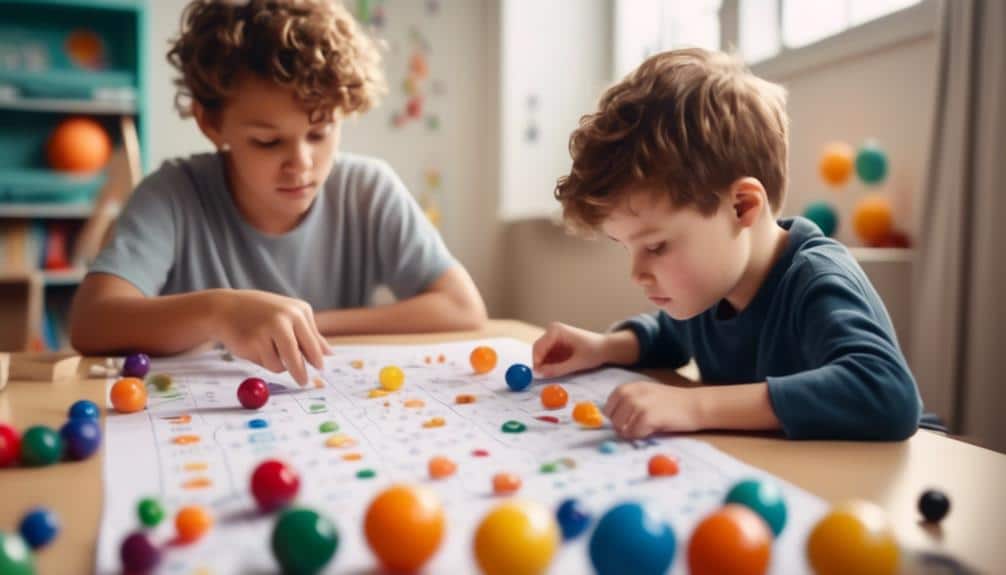The progressive field of occupational therapy offers a multifaceted approach to addressing the diverse needs of kids with autism, aiming to equip them with the essential skills for navigating the complexities of everyday life. As therapists tailor interventions to support sensory integration, fine motor skills, and adaptive behavior, they lay the groundwork for improved self-regulation and social interaction. However, the efficacy of these interventions hinges on a comprehensive understanding of the child’s unique sensory profile and the intricate dynamics between their environment and behavior. In navigating this intricate landscape, parents and professionals may wonder about the strategies underlying successful occupational therapy outcomes.
While evidence points to the positive impacts of such therapies, the question remains: how exactly does occupational therapy transform the potential challenges of autism into opportunities for growth and autonomy? The answer may reshape how we support kids with autism in their developmental journey.
Key Takeaways
- Sensory integration is crucial for autistic children’s development and social interactions.
- Occupational therapy assessments and personalized therapy goals are essential for addressing individual challenges and promoting progress.
- Engaging families in therapy enhances outcomes and supports the child’s development at home.
- Sensory diets and OT techniques tailored to each child’s needs help improve motor skills, social interaction, and sensory processing.
Understanding Sensory Integration
Sensory integration is the neurological foundation that enables children, including those with autism, to interpret and interact with the world around them. The brain’s innate capacity to process and organize sensory information, such as touch, sound, and movement, facilitates a coherent understanding of one’s environment. This integrative process is instrumental in developing motor skills, behavioral regulation, and social interactions.
For children with autism, sensory integration can present significant challenges, impacting their ability to engage in daily activities and social exchanges. They may experience hypersensitivities to stimuli that others find unremarkable, or conversely, they might seek out intense sensory experiences. These sensory processing difficulties can manifest as behavioral outbursts, anxiety, or withdrawal, creating barriers to learning and socialization.
Occupational therapists specializing in sensory integration employ various strategies to assist these children. By designing tailored sensory diets, creating supportive environments, and guiding them through structured activities, therapists help children with autism navigate their sensory landscape. This therapeutic approach fosters the child’s ability to process sensory input more effectively, enhancing participation in life’s activities and improving functional outcomes.
Importance of Sensory Processing
The ability to efficiently process sensory information is essential for children to interact with and make sense of the world, significantly influencing their cognitive development and social interactions. For children on the autism spectrum, integrating and processing sensory stimuli can be particularly challenging, which can profoundly affect their daily lives.
Occupational therapy plays a pivotal role in addressing these sensory processing issues. Through tailored strategies and interventions, occupational therapists aim to enhance the sensory processing abilities of autistic children, thereby improving their functional outcomes. These interventions are crucial not only for the child’s immediate well-being but also for their long-term development and independence.
Consider the following aspects of sensory processing that underscore its importance:
- Sensory processing is foundational for learning and engaging with educational materials.
- Proper sensory integration facilitates social participation by helping children understand and respond to social cues.
- Addressing sensory challenges can reduce behavioral issues linked to overwhelming or distressing sensory experiences.
- Customizing a sensory-friendly environment and implementing a sensory diet fosters a supportive context for growth and development.
Occupational therapists employ a compassionate and practical approach, empowering children with the tools to navigate their sensory experiences more effectively.
OT Assessment Strategies

Evaluating a child with autism’s abilities in daily activities such as learning, play, and self-care is a fundamental component of occupational therapy assessment strategies. This evaluation process is essential for uncovering the specific challenges a child may face daily, thereby guiding the development of a personalized treatment plan. The assessment identifies barriers that impede the child’s functional performance and participation in activities, which is crucial for setting achievable goals.
Occupational therapy goals for children with autism often center on essential life skills. These can include independent dressing, eating, grooming, using the bathroom, and developing fine motor skills necessary for writing and utensils. Each goal is tailored to the child’s unique needs, fostering a sense of autonomy and competence.
Pediatric occupational therapy sessions, lasting from thirty minutes to an hour, are designed with the child’s specific goals. Notably, the strategies and skills introduced during these sessions are intended to be practiced and reinforced outside therapy, ensuring the child can integrate them into everyday life. This holistic approach to evaluation and treatment acknowledges each child’s needs, laying a foundation for meaningful progress in occupational therapy.
Personalized Therapy Goals
In occupational therapy, setting personalized goals is fundamental to supporting the diverse needs of autistic children. By tailoring individual skill targets, therapists can create a roadmap to enhance essential life skills through achievable milestones. This collaborative approach empowers the child and involves the family, fostering an environment where therapy extends beyond clinical settings into daily routines.
Tailoring Individual Skill Targets
Understanding each autistic child’s distinct challenges and needs is crucial in formulating personalized occupational therapy goals that target specific skill development. Occupational therapists must assess the child’s abilities and barriers to appropriately tailor these goals. The individualized nature of these targets allows for a focused approach to therapy, which is essential for the child’s progression in critical developmental areas. The personalized goals typically include:
- Enhancing fine motor skills for improved coordination
- Developing self-care routines to foster independence
- Building social skills to navigate interpersonal interactions better
- Improving sensory processing and communication abilities
These goals are not only concentrated on within therapy sessions. Still, they are encouraged to be practiced in the child’s daily environment to ensure consistent progress and generalization of learned skills.
Setting Achievable Milestones
Setting personalized therapy milestones for autistic children is a strategic process that requires careful consideration of each child’s developmental trajectory and potential. By setting clear, attainable goals, we acknowledge every child’s unique path and honor their individuality. It is a collaborative effort, engaging therapists, parents, and children, ensuring that milestones are tailored and celebrated, fostering a sense of achievement and motivation.
| Milestone | Emotional Impact |
|---|---|
| First Words | Joy and Hope |
| Solo Play | Independence and Pride |
| New Routine | Security and Trust |
| Social Interaction | Connection and Belonging |
Such milestones, grounded in the SMART criteria, are stepping stones that build a child’s confidence and skills compassionately and practically, guiding them toward their fullest potential.
Engaging Family in Therapy
Engaging families in the therapy process empowers them to contribute vital insights that can shape more personalized and effective therapy goals for autistic children. Involving parents and caregivers is essential to crafting a therapy plan that is relevant and sustainable outside the clinical setting. Here are critical steps in engaging families:
- Collaborate with family members to identify and prioritize the child’s needs.
- Foster open dialogue to understand the child’s daily routines and challenges.
- Provide families with tools and strategies to support the child’s development at home.
- Ensure therapy goals are flexible and adaptable to the child’s evolving progress and family dynamics.
This inclusive approach enhances the therapy’s impact, promoting consistency and continuity in the child’s learning and growth.
Sensory Diet Explained
A sensory diet, carefully tailored by occupational therapists, is an individualized plan that strategically incorporates sensory activities into a child’s daily routine to enhance their ability to self-regulate, focus, and adapt to their environment. This regimen is not about food but rather about enriching sensory experiences that can help an autistic child navigate their day with greater ease. The sensory diet is crucial for fostering the development of self-regulation strategies, preventing sensory overload, and decreasing stress. This approach recognizes that each child is unique, so their sensory diet must be custom-designed to suit their needs and daily demands.
The structured sensory activities within the diet are chosen to stimulate or calm the child, depending on their current state of arousal. This balance is essential to help them maintain optimal alertness for learning and interacting. Below is a simplified table to illustrate how a sensory diet might look:
| Time of Day | Sensory Activity |
|---|---|
| Morning | Joint compressions to awaken the body |
| Afternoon | Calming deep-pressure activities |
| Evening | Soothing audio stimulation for relaxation |
Through these planned activities, children learn to recognize their behaviors and emotions, increasing their ability to adapt and cope with various sensory inputs. The ultimate goal is to empower these young individuals to meet the challenges of their environment with confidence and skill.
OT Techniques for Autism

Occupational therapy (OT) for autistic children employs a variety of techniques tailored to each child’s unique needs. Sensory integration methods are integral in helping children process and respond to sensory stimuli while fostering social skills is critical for their interaction and communication with others. Mastery of daily living activities is a further cornerstone of OT, enabling these children to achieve greater independence and confidence in their everyday lives.
Sensory Integration Methods
Sensory integration methods, developed within the framework of occupational therapy, are designed to help autistic children navigate and manage their unique sensory preferences and challenges. These methods facilitate better engagement in daily activities by addressing sensory processing issues. Occupational therapists strategically employ various tools and techniques to create a structured sensory environment that promotes optimal functioning for each child.
- Sensory Diets: Personalized activities that provide a child’s sensory input to stay focused and organized.
- Regulation Exercises: Activities that help the child modulate their responses to sensory stimuli.
- Environment Recommendations: Advice for creating sensory-friendly spaces that reduce the likelihood of sensory overload.
- Desensitization Techniques: Gradual exposure to sensitive stimuli to decrease adverse reactions.
These methods are tailored to be empathetic to the child’s experience and practical for caregivers to implement.
Social Skills Development
Developing social skills is a critical component of occupational therapy for autistic children, employing strategies such as social stories and role-playing to enhance communication and interaction. Occupational therapists tailor these strategies to meet the unique needs of each child, focusing on practical, everyday social interactions. Children can practice and refine these skills through structured social skills groups in a safe and supportive environment.
The therapy aims to improve joint attention and turn-taking, which are essential for engaging with others. By addressing play skills, therapists facilitate more natural peer interactions. Additionally, occupational therapy provides critical support in managing challenging behaviors that can inhibit successful social exchanges. The ultimate goal is to equip autistic children with the social tools necessary for meaningful connections with their peers and community.
Daily Living Activities Mastery
Mastering daily living activities is a cornerstone of occupational therapy for children with autism, as it encompasses essential self-care tasks that foster independence and improve quality of life. Occupational therapists create comprehensive programs that are:
- It is tailored to individual capabilities and challenges, ensuring a personalized approach.
- We are focused on incrementally teaching dressing, grooming, and feeding skills.
- They are designed to incorporate sensory integration techniques for those with hypersensitivity.
- They are supported by strategies that can be consistently applied at home and in other settings.
These programs are structured around the child’s unique needs, emphasizing patience, encouragement, and celebrating small victories. By partnering with parents and caregivers, occupational therapists ensure the techniques used in sessions are reinforced in the child’s daily routine, thus promoting a seamless skills transition across environments.
Improving Motor Skills

Enhancing fine motor skills in autistic children is a primary focus of occupational therapy, aiming to bolster hand muscle strength and hand-eye coordination critical for everyday tasks. Occupational therapists use various techniques to break down complex tasks into manageable steps, fostering independence and confidence in the children they serve.
These professionals take an individualized approach, assessing each child’s unique needs and creating tailored treatment plans. Collaborative efforts with parents, caregivers, and other professionals are vital to ensure consistent progress and holistic development.
Here is a table that outlines critical strategies used in occupational therapy to improve motor skills:
| Strategy | Objective | Example Activity |
|---|---|---|
| Hand Strengthening | Increase muscle tone | Squeezing stress balls |
| Hand-Eye Coordination | Enhance precision | Threading beads |
| Task Breakdown | Simplify self-care tasks | Practicing buttoning |
| Sensory Integration | Improve sensory response | Playing with textured materials |
| Social Stories/Role-Playing | Facilitate social skills | Pretending to set a table |
Occupational therapy for autistic children is empathetic and practical, providing a patient and supportive environment to learn and grow. By improving motor skills, children can perform daily activities with greater independence, leading to an enriched quality of life.
Enhancing Daily Living Skills
Occupational therapy plays a vital role in assisting kids with autism to master essential self-care routines, fostering a sense of autonomy and confidence. By improving participation in household tasks, therapists encourage skill development in a familiar and functional context for the child. These interventions are pivotal in promoting an independent and fulfilling life, enabling children to contribute meaningfully to their family and daily environment.
Mastering Self-Care Routines
For many autistic children, acquiring self-care skills such as grooming, dressing, and feeding is a fundamental goal of occupational therapy to foster independence in daily living. These essential routines are critical for the child’s sense of autonomy and self-esteem and ease the demands on caregivers. Occupational therapists employ a variety of strategies to enhance these skills:
- We are developing fine motor skills to aid in buttoning clothes and using utensils effectively.
- Creating and implementing individualized treatment plans focusing on the child’s specific needs.
- We utilize tools like social stories to facilitate the understanding and executing daily routines.
- We are collaborating with parents and caregivers to ensure consistency and reinforcement of learned skills at home.
Through these personalized and empathetic approaches, occupational therapists play a pivotal role in helping autistic children master self-care routines.
Improving Household Participation
Building upon the foundational self-care routines, occupational therapy is vital in improving household participation and daily living skills for kids with autism. By enhancing fine motor skills and addressing social interactions, therapists empower children to engage in household tasks such as setting the table and sorting laundry, which fosters independence and confidence. Sensory-friendly strategies ensure children can navigate their environments comfortably, making participation less overwhelming.
| Skills Improved | Household Activities |
|---|---|
| Fine Motor Skills | Writing, Using Utensils |
| Daily Living Skills | Dressing, Grooming |
| Social Skills | Communication, Play |
| Sensory Integration | Managing Sensitivities |
Collaborating with families, therapists facilitate the transference of these skills to the home setting, tailoring interventions to meet each child’s unique needs and ensuring continuity in their development.
Social Interaction Enhancement

Enhancing social interaction skills in autistic children, occupational therapists employ various strategies to foster improved communication and peer engagement. By emphasizing the development of these skills, occupational therapy facilitates the child’s ability to form meaningful relationships and participate more fully in social contexts. The therapy sessions are carefully structured to provide a supportive environment where children can learn and practice social nuances.
To enhance social interaction, occupational therapists may incorporate the following techniques:
- Role-playing exercises to rehearse and understand various social scenarios.
- Social stories aid in the comprehension of expected behaviors in given situations.
- Group therapy sessions to practice interaction with peers in a controlled setting.
- Sensory integration activities to help manage sensory sensitivities that may impact socialization.
This approach teaches the children and empowers them to navigate the social world confidently. The ultimate goal of such interventions is to improve their ability to engage with others, thereby enhancing their quality of life. In this pursuit, occupational therapists act with compassion and expertise, tailoring their methods to the unique needs of each child, ensuring that the strategies employed are both practical and beneficial.
Multidisciplinary Collaboration
In supporting kids with autism, multidisciplinary collaboration emerges as a vital approach, bringing together professionals from various specialties to forge a unified front in addressing the multifaceted needs of these young individuals. By integrating the expertise of occupational therapists, speech therapists, psychologists, educators, and medical professionals, this collaborative effort ensures a holistic approach that considers every aspect of a child’s development.
Each professional contributes a unique perspective, enabling the creation of comprehensive and individualized intervention plans. Occupational therapists focus on enhancing daily living skills and sensory integration, speech therapists work on communication abilities, psychologists assist with emotional regulation, educators adapt educational strategies, and medical professionals oversee related health concerns.
The central aim of this collaboration is to maximize the child’s progress and overall well-being. It moves beyond isolated treatment modalities to a more cohesive strategy that aligns with the child’s needs and family dynamics. This cooperative model fosters a supportive network for children on the autism spectrum, ensuring that every child can thrive uniquely. Through such partnerships, the potential for positive outcomes is significantly amplified, reinforcing the essential role of teamwork in the journey toward empowerment.
Measuring Therapy Outcomes

Recognizing the importance of multidisciplinary efforts, it remains equally crucial to employ methods for accurately measuring therapy outcomes to ensure the efficacy of interventions for autistic children. Reliable and consistent outcome measurement tools are indispensable in gauging the success of pediatric occupational therapy programs, enabling clinicians to tailor interventions that maximize the child’s potential and improve their quality of life.
When evaluating the progress of autistic children in occupational therapy, several key areas are considered:
- Daily Living Skills: Assessing the child’s ability to perform everyday tasks, such as dressing, eating, and personal hygiene.
- Social Interaction: Monitoring improvements in the child’s ability to engage with others and navigate social situations.
- Sensory Integration: Observing the child’s response to sensory stimuli and their ability to regulate sensory input.
- Behavioral Changes: Noting any shifts in behavior patterns that indicate increased coping strategies and reduced stress.
These components are tracked using various tools, including standardized assessments that provide objective data, observational techniques, and feedback from parents or caregivers. The combined insights from these measures paint a comprehensive picture of the child’s progression, ensuring that the support provided is impactful and aligned with the child’s unique needs.
Frequently Asked Questions
How Can Occupational Therapy Help Kids With Autism?
Occupational therapy aids autistic children by developing essential life skills, facilitating social interaction, and managing sensory challenges, ultimately promoting greater independence and integration into various aspects of daily life.
What Are ADL Activities for Kids with Autism?
ADL activities for autism encompass essential self-care tasks, from brushing teeth to dressing, crucial for fostering independence and self-sufficiency in daily living, tailored to each child’s unique abilities and needs.
What Are the 3 Forms of Early Intervention for Autism?
The three forms of early intervention for autism are behavioral therapy, which modifies harmful behaviors; speech-language therapy, which improves communication; and occupational therapy, focusing on daily living and motor skills development.
What Occupational Therapy Activities Are Appropriate for High Functioning Autism?
For high-functioning autism, occupational therapy may include fine motor skill exercises, enhancement of social skills, sensory integration interventions, and activities geared toward improving self-care, organization, and time management.
Conclusion
Occupational therapy can be a critical step in helping children with autism spectrum disorders develop essential life skills. Sensory input, including light and body awareness, can be crucial for children with autism, and occupational therapy can help them develop strategies for managing challenging behaviors and better understanding their bodies. Occupational therapy can also help children develop communication skills, including body language and eye contact, and social skills for navigating social situations.
Step by step, occupational therapy can help children with autism develop a daily routine that includes a wide range of sensory, physical, self-care, and brain activities. A visual schedule can be a helpful resource for children with autism, providing a checklist of activities to help them move from activity to activity.
Sharing time with others can be essential to occupational therapy, and children with autism can benefit from cooperative and social skills activities. Play-based activities can also be helpful for children with autism, providing opportunities for them to explore their world and develop new skills.
Occupational therapy can also help children with autism develop essential life skills, such as managing their daily schedule, understanding family routines, and selecting food items that are good for their bodies. Paper plates, paper clips, and plastic bottles can be used creatively to provide fun activities for kids with autism. In contrast, wooden spoons and pipe cleaners can be used for more active listening and physical activities.
There are many resources available for families of children with autism, including Autism Connections and DIRFloortime. Speech therapists can also be a helpful resource for children with autism, providing additional support for communication issues.
Overall, occupational therapy can be a helpful resource for kids with autism, providing ample opportunities for positive behavior, socialization, and quality of life. By providing a supportive and structured environment, children with autism can learn to navigate their world better and develop skills that will serve them well throughout their lives.


Recent Comments